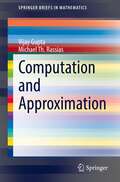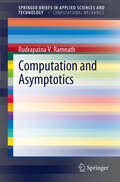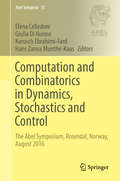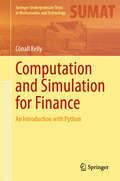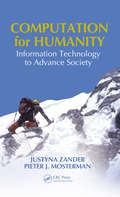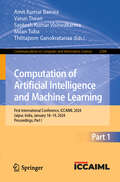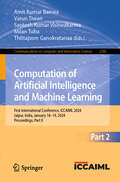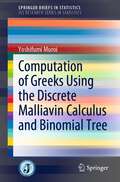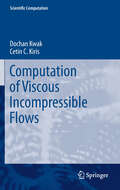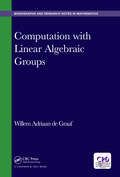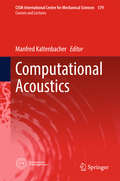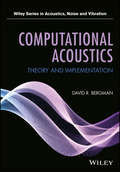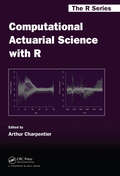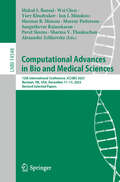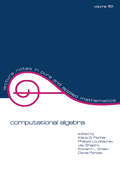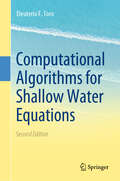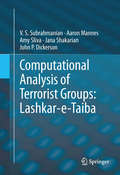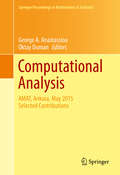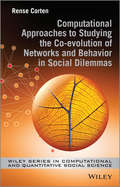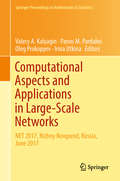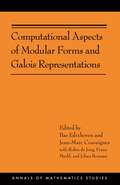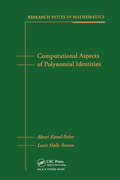- Table View
- List View
Computation and Approximation (SpringerBriefs in Mathematics)
by Vijay Gupta Michael Th. RassiasThis brief studies recent work conducted on certain exponential type operators and other integral type operators. It consists of three chapters: the first on exponential type operators, the second a study of some modifications of linear positive operators, and the third on difference estimates between two operators. It will be of interest to students both graduate and undergraduate studying linear positive operators and the area of approximation theory.
Computation and Asymptotics (SpringerBriefs in Applied Sciences and Technology)
by Rudrapatna V. RamnathThis book addresses the task of computation from the standpoint of asymptotic analysis and multiple scales that may be inherent in the system dynamics being studied. This is in contrast to the usual methods of numerical analysis and computation. The technical literature is replete with numerical methods such as Runge-Kutta approach and its variations, finite element methods, and so on. However, not much attention has been given to asymptotic methods for computation, although such approaches have been widely applied with great success in the analysis of dynamic systems. The presence of different scales in a dynamic phenomenon enable us to make judicious use of them in developing computational approaches which are highly efficient. Many such applications have been developed in such areas as astrodynamics, fluid mechanics and so on. This book presents a novel approach to make use of the different time constants inherent in the system to develop rapid computational methods. First, the fundamental notions of asymptotic analysis are presented with classical examples. Next, the novel systematic and rigorous approaches of system decomposition and reduced order models are presented. Next, the technique of multiple scales is discussed. Finally application to rapid computation of several aerospace systems is discussed, demonstrating the high efficiency of such methods.
Computation and Combinatorics in Dynamics, Stochastics and Control: The Abel Symposium, Rosendal, Norway, August 2016 (Abel Symposia #13)
by Giulia Di Nunno Kurusch Ebrahimi-Fard Elena Celledoni Hans Zanna Munthe-Kaas<p>The Abel Symposia volume at hand contains a collection of high-quality articles written by the world’s leading experts, and addressing all mathematicians interested in advances in deterministic and stochastic dynamical systems, numerical analysis, and control theory. <p>In recent years we have witnessed a remarkable convergence between individual mathematical disciplines that approach deterministic and stochastic dynamical systems from mathematical analysis, computational mathematics and control theoretical perspectives. Breakthrough developments in these fields now provide a common mathematical framework for attacking many different problems related to differential geometry, analysis and algorithms for stochastic and deterministic dynamics. In the Abel Symposium 2016, which took place from August 16-19 in Rosendal near Bergen, leading researchers in the fields of deterministic and stochastic differential equations, control theory, numerical analysis, algebra and random processes presented and discussed the current state of the art in these diverse fields. <p>The current Abel Symposia volume may serve as a point of departure for exploring these related but diverse fields of research, as well as an indicator of important current and future developments in modern mathematics.</p>
Computation and Modelling in Insurance and Finance
by Erik BølvikenFocusing on what actuaries need in practice, this introductory account provides readers with essential tools for handling complex problems and explains how simulation models can be created, used and re-used (with modifications) in related situations. The book begins by outlining the basic tools of modelling and simulation, including a discussion of the Monte Carlo method and its use. Part II deals with general insurance and Part III with life insurance and financial risk. Algorithms that can be implemented on any programming platform are spread throughout and a program library written in R is included. Numerous figures and experiments with R-code illustrate the text. The author's non-technical approach is ideal for graduate students, the only prerequisites being introductory courses in calculus and linear algebra, probability and statistics. The book will also be of value to actuaries and other analysts in the industry looking to update their skills.
Computation and Simulation for Finance: An Introduction with Python (Springer Undergraduate Texts in Mathematics and Technology)
by Cónall KellyThis book offers an up-to-date introductory treatment of computational techniques applied to problems in finance, placing issues such as numerical stability, convergence and error analysis in both deterministic and stochastic settings at its core. The first part provides a welcoming but nonetheless rigorous introduction to the fundamental theory of option pricing, including European, American, and exotic options along with their hedge parameters, and combines a clear treatment of the mathematical framework with practical worked examples in Python. The second part explores the main computational methods for valuing options within the Black-Scholes framework: lattice, Monte Carlo, and finite difference methods. The third and final part covers advanced topics for the simulation of financial processes beyond the standard Black-Scholes setting. Techniques for the analysis and simulation of multidimensional financial data, including copulas, are covered and will be of interest to those studying machine learning for finance. There is also an in-depth treatment of exact and approximate sampling methods for stochastic differential equation models of interest rates and volatilities. Written for advanced undergraduate and masters-level courses, the book assumes some exposure to core mathematical topics such as linear algebra, ordinary differential equations, multivariate calculus, probability, and statistics at an undergraduate level. While familiarity with Python is not required, readers should be comfortable with basic programming constructs such as variables, loops, and conditional statements.
Computation for Humanity: Information Technology to Advance Society (Computational Analysis, Synthesis, and Design of Dynamic Systems)
by Pieter J. Mosterman Justyna ZanderThe exponential progress and accessibility of computing has vastly increased data flows and revolutionized the practice of science, engineering, and communication. Computing plays a critical role in advancing research across almost every scientific discipline. Computation for Humanity: Information Technology to Advance Society is a guide for the creation of services, products, and tools that facilitate, support, and enhance progress of humanity toward more sustainable life. This book: Provides a deep understanding of the practical applications of computation to solve human-machine problems Delivers insight into theoretical approaches in an accessible manner Provides a comprehensive overview of computational science and engineering applications in selected disciplines Crosses the boundaries between different domains and shows how they interrelate and complement one another Focuses on grand challenges and issues that matter for the future of humanity Shows different perspectives of computational thinking, understanding, and reasoning Provides a basis for scientific discoveries and enables adopting scientific theories and engineering practices from other disciplines Takes a step back to provide a human-related abstraction level that is not ultimately seen in pure technological elaborations/collections The editors provide a collection of numerous computation-related projects that form a foundation from which to cross-pollinate between different disciplines and further extensive collaboration. They present a clear and profound understanding of computing in today's world, and provide fundamental solutions to some of the most pertinent humanity-related problems.
Computation of Artificial Intelligence and Machine Learning: First International Conference, ICCAIML 2024, Jaipur, India, January 18–19, 2024, Proceedings, Part I (Communications in Computer and Information Science #2184)
by Milan Tuba Amit Kumar Bairwa Varun Tiwari Santosh Kumar Vishwakarma Thittaporn GanokratanaaThe two-volume set, CCIS 2184-2185, constitutes the refereed proceedings of the First International Conference on Computation of Artificial Intelligence and Machine Learning, ICCAIML 2024, held in Jaipur, India, in January 18–19, 2024. The 60 papers included in these volumes were carefully reviewed and selected from 645 submissions. These papers focus on various subject areas within the field of Artificial Intelligence and Machine Learning, such as Neural Networks and Deep Learning, Natural Language Processing, Computer Vision, Reinforcement Learning, Data Mining and Big Data Analytics, AI in Healthcare and Biomedical Applications, Autonomous Systems and Robotics, AI Ethics and Fairness, AI in Finance and Eco-nomics.
Computation of Artificial Intelligence and Machine Learning: First International Conference, ICCAIML 2024, Jaipur, India, January 18–19, 2024, Proceedings, Part II (Communications in Computer and Information Science #2185)
by Milan Tuba Amit Kumar Bairwa Varun Tiwari Santosh Kumar Vishwakarma Thittaporn GanokratanaaThe two-volume set, CCIS 2184-2185, constitutes the refereed proceedings of the First International Conference on Computation of Artificial Intelligence and Machine Learning, ICCAIML 2024, held in Jaipur, India, in January 18–19, 2024. The 60 papers included in these volumes were carefully reviewed and selected from 645 submissions. These papers focus on various subject areas within the field of Artificial Intelligence and Machine Learning, such as Neural Networks and Deep Learning, Natural Language Processing, Computer Vision, Reinforcement Learning, Data Mining and Big Data Analytics, AI in Healthcare and Biomedical Applications, Autonomous Systems and Robotics, AI Ethics and Fairness, AI in Finance and Eco-nomics.
Computation of Greeks Using the Discrete Malliavin Calculus and Binomial Tree (SpringerBriefs in Statistics)
by Yoshifumi MuroiThis book presents new computation schemes for the sensitivity of options using the binomial tree and introduces readers to the discrete Malliavin calculus. It also shows that applications of the discrete Malliavin calculus approach to the binomial tree model offer fundamental tools for computing Greeks.The binomial tree approach is one of the most popular methods in option pricing. Although it is a fairly traditional model for option pricing, it is still widely used in financial institutions since it is tractable and easy to understand. However, the book shows that the tree approach also offers a powerful tool for deriving the Greeks for options. Greeks are quantities that represent the sensitivities of the price of derivative securities with respect to changes in the underlying asset price or parameters. The Malliavin calculus, the stochastic methods of variations, is one of the most popular tools used to derive Greeks. However, it is also very difficult to understand for most students and practitioners because it is based on complex mathematics. To help readers more easily understand the Malliavin calculus, the book introduces the discrete Malliavin calculus, a theory of the functional for the Bernoulli random walk. The discrete Malliavin calculus is significantly easier to understand, because the functional space of the Bernoulli random walk is realized in a finite dimensional space. As such, it makes this valuable tool far more accessible for a broad readership.
Computation of Viscous Incompressible Flows (Scientific Computation)
by Cetin C. Kiris Dochan KwakThis monograph is intended as a concise and self-contained guide to practitioners and graduate students for applying approaches in computational fluid dynamics (CFD) to real-world problems that require a quantification of viscous incompressible flows. In various projects related to NASA missions, the authors have gained CFD expertise over many years by developing and utilizing tools especially related to viscous incompressible flows. They are looking at CFD from an engineering perspective, which is especially useful when working on real-world applications. From that point of view, CFD requires two major elements, namely methods/algorithm and engineering/physical modeling. As for the methods, CFD research has been performed with great successes. In terms of modeling/simulation, mission applications require a deeper understanding of CFD and flow physics, which has only been debated in technical conferences and to a limited scope. This monograph fills the gap by offering in-depth examples for students and engineers to get useful information on CFD for their activities. The procedural details are given with respect to particular tasks from the authors' field of research, for example simulations of liquid propellant rocket engine subsystems, turbo-pumps and the blood circulations in the human brain as well as the design of artificial heart devices. However, those examples serve as illustrations of computational and physical challenges relevant to many other fields. Unlike other books on incompressible flow simulations, no abstract mathematics are used in this book. Assuming some basic CFD knowledge, readers can easily transfer the insights gained from specific CFD applications in engineering to their area of interest.
Computation with Linear Algebraic Groups (Chapman & Hall/CRC Monographs and Research Notes in Mathematics)
by Willem Adriaan de GraafDesigned as a self-contained account of a number of key algorithmic problems and their solutions for linear algebraic groups, this book combines in one single text both an introduction to the basic theory of linear algebraic groups and a substantial collection of useful algorithms. Computation with Linear Algebraic Groups offers an invaluable guide to graduate students and researchers working in algebraic groups, computational algebraic geometry, and computational group theory, as well as those looking for a concise introduction to the theory of linear algebraic groups.
Computation, Proof, Machine
by Gilles DowekComputation is revolutionizing our world, even the inner world of the 'pure' mathematician. Mathematical methods - especially the notion of proof - that have their roots in classical antiquity have seen a radical transformation since the 1970s, as successive advances have challenged the priority of reason over computation. Like many revolutions, this one comes from within. Computation, calculation, algorithms - all have played an important role in mathematical progress from the beginning - but behind the scenes, their contribution was obscured in the enduring mathematical literature. To understand the future of mathematics, this fascinating book returns to its past, tracing the hidden history that follows the thread of computation. Along the way it invites us to reconsider the dialog between mathematics and the natural sciences, as well as the relationship between mathematics and computer science. It also sheds new light on philosophical concepts, such as the notions of analytic and synthetic judgment. Finally, it brings us to the brink of the new age, in which machine intelligence offers new ways of solving mathematical problems previously inaccessible. This book is the 2007 winner of the Grand Prix de Philosophie de l'Académie Française.
Computational Acoustics (CISM International Centre for Mechanical Sciences #579)
by Manfred KaltenbacherThe book presents a state-of-art overview of numerical schemes efficiently solving the acoustic conservation equations (unknowns are acoustic pressure and particle velocity) and the acoustic wave equation (pressure of acoustic potential formulation). Thereby, the different equations model both vibrational- and flow-induced sound generation and its propagation. Latest numerical schemes as higher order finite elements, non-conforming grid techniques, discontinuous Galerkin approaches and boundary element methods are discussed. Main applications will be towards aerospace, rail and automotive industry as well as medical engineering. The team of authors are able to address these topics from the engineering as well as numerical points of view.
Computational Acoustics: Theory and Implementation
by David R. BergmanCovers the theory and practice of innovative new approaches to modelling acoustic propagation There are as many types of acoustic phenomena as there are media, from longitudinal pressure waves in a fluid to S and P waves in seismology. This text focuses on the application of computational methods to the fields of linear acoustics. Techniques for solving the linear wave equation in homogeneous medium are explored in depth, as are techniques for modelling wave propagation in inhomogeneous and anisotropic fluid medium from a source and scattering from objects. Written for both students and working engineers, this book features a unique pedagogical approach to acquainting readers with innovative numerical methods for developing computational procedures for solving problems in acoustics and for understanding linear acoustic propagation and scattering. Chapters follow a consistent format, beginning with a presentation of modelling paradigms, followed by descriptions of numerical methods appropriate to each paradigm. Along the way important implementation issues are discussed and examples are provided, as are exercises and references to suggested readings. Classic methods and approaches are explored throughout, along with comments on modern advances and novel modeling approaches. Bridges the gap between theory and implementation, and features examples illustrating the use of the methods described Provides complete derivations and explanations of recent research trends in order to provide readers with a deep understanding of novel techniques and methods Features a systematic presentation appropriate for advanced students as well as working professionals References, suggested reading and fully worked problems are provided throughout An indispensable learning tool/reference that readers will find useful throughout their academic and professional careers, this book is both a supplemental text for graduate students in physics and engineering interested in acoustics and a valuable working resource for engineers in an array of industries, including defense, medicine, architecture, civil engineering, aerospace, biotech, and more.
Computational Actuarial Science with R (Chapman And Hall/crc The R Ser. #17)
by Arthur CharpentierA Hands-On Approach to Understanding and Using Actuarial ModelsComputational Actuarial Science with R provides an introduction to the computational aspects of actuarial science. Using simple R code, the book helps you understand the algorithms involved in actuarial computations. It also covers more advanced topics, such as parallel computing and C/
Computational Advances in Bio and Medical Sciences: 12th International Conference, ICCABS 2023, Norman, OK, USA, December 11–13, 2023, Revised Selected Papers (Lecture Notes in Computer Science #14548)
by Wei Chen Alexander Zelikovsky Pavel Skums Sanguthevar Rajasekaran Yury Khudyakov Sharma V. Thankachan Mukul S. Bansal Murray Patterson Ion I. Măndoiu Marmar R. MoussaThis book constitutes the refereed proceedings of the 12th International Conference on Computational Advances in Bio and Medical Sciences, ICCABS 2023, held in Norman, Oklahoma, USA, during December 11–13, 2023. The 23 full papers included in this book were carefully reviewed and selected from 65 submissions. These papers focus on the recent advances in Computational techniques and applications in the areas of Biology, Medicine, and Drug discovery.
Computational Algebra (Lecture Notes In Pure And Applied Mathematics Ser. #151)
by Klaus G. Fischer Philippe Loustaunau Jay Shapiro Edward L. Green Daniel FarkasBased on the fifth Mid-Atlantic Algebra Conference held recently at George Mason University, Fairfax, Virginia. Focuses on both the practical and theoretical aspects of computational algebra. Demonstrates specific computer packages, including the use of CREP to study the representation of theory for finite dimensional algebras and Axiom to study algebras of finite rank.
Computational Algorithms for Shallow Water Equations
by Eleuterio F. ToroThis book is a thoroughly revised and enlarged version of “Shock-capturing methods for free-surface shallow flows", first published by Wiley and Sons, 2001. The book describes mathematically free-surface flows through partial differential equations and includes modern shock-capturing methods to solve them, with strong emphasis on finite volume upwind and centred methods. Such equations and methods are fundamental in simulating shallow water flows but also atmospheric flows, dispersion of dense gases and the dynamics of mixtures of materials. The book is accompanied by numerical software in the form of sample computer programs as supplementary material. In this new edition, additional sections have been introduced to existing chapters. Also, new chapters have been included; one contains a review of the mathematics of hyperbolic partial differential equations, another introduces the numerical analysis of partial differential equations and another one deals with advanced very-high order numerical methods in the finite volume and discontinuous Galerkin frameworks. Furthermore, comprehensive modifications and corrections have been made throughout various sections of the text, and numerous figures depicting numerical results have been enhanced. This book is primarily intended for environmental scientists, applied mathematicians and engineers in academia, research laboratories, industry and consultancy organisations. Senior undergraduate and postgraduate students involved with mathematical modelling and computational methods for environmental problems will benefit from studying this book. Lecturers could use most of the material for courses on numerical methods for wave propagation problems in hydraulics, oceanography, atmospherics and other geophysical fluid dynamics contexts.
Computational Analysis of Randomness in Structural Mechanics: Structures and Infrastructures Book Series, Vol. 3 (Structures and Infrastructures)
by Christian BucherProper treatment of structural behavior under severe loading - such as the performance of a high-rise building during an earthquake - relies heavily on the use of probability-based analysis and decision-making tools. Proper application of these tools is significantly enhanced by a thorough understanding of the underlying theoretical and computation
Computational Analysis of Terrorist Groups: Lashkar-e-taiba
by Amy Sliva V. S. Subrahmanian John P. Dickerson Jana Shakarian Aaron MannesComputational Analysis of Terrorist Groups: Lashkar-e-Taiba provides an in-depth look at Web intelligence, and how advanced mathematics and modern computing technology can influence the insights we have on terrorist groups. This book primarily focuses on one famous terrorist group known as Lashkar-e-Taiba (or LeT), and how it operates. After 10 years of counter Al Qaeda operations, LeT is considered by many in the counter-terrorism community to be an even greater threat to the US and world peace than Al Qaeda. Computational Analysis of Terrorist Groups: Lashkar-e-Taiba is the first book that demonstrates how to use modern computational analysis techniques including methods for "big data" analysis. This book presents how to quantify both the environment in which LeT operate, and the actions it took over a 20-year period, and represent it as a relational database table. This table is then mined using sophisticated data mining algorithms in order to gain detailed, mathematical, computational and statistical insights into LeT and its operations. This book also provides a detailed history of Lashkar-e-Taiba based on extensive analysis conducted by using open source information and public statements. Each chapter includes a case study, as well as a slide describing the key results which are available on the authors' web sites. Computational Analysis of Terrorist Groups: Lashkar-e-Taiba is designed for a professional market composed of government or military workers, researchers and computer scientists working in the web intelligence field. Advanced-level students in computer science will also find this valuable as a reference book.
Computational Analysis: AMAT, Ankara, May 2015 Selected Contributions (Springer Proceedings in Mathematics & Statistics #155)
by Oktay Duman George A. A. AnastassiouFeaturing the clearly presented and expertly-refereed contributions of leading researchers in the field of approximation theory, this volume is a collection of the best contributions at the Third International Conference on Applied Mathematics and Approximation Theory, an international conference held at TOBB University of Economics and Technology in Ankara, Turkey, on May 28-31, 2015. The goal of the conference, and this volume, is to bring together key work from researchers in all areas of approximation theory, covering topics such as ODEs, PDEs, difference equations, applied analysis, computational analysis, signal theory, positive operators, statistical approximation, fuzzy approximation, fractional analysis, semigroups, inequalities, special functions and summability. These topics are presented both within their traditional context of approximation theory, while also focusing on their connections to applied mathematics. As a result, this collection will be an invaluable resource for researchers in applied mathematics, engineering and statistics.
Computational Approaches to Studying the Co-evolution of Networks and Behavior in Social Dilemmas
by Rense CortenComputational Approaches to Studying the Co-evolution of Networks and Behaviour in Social Dilemmas shows students, researchers, and professionals how to use computation methods, rather than mathematical analysis, to answer research questions for an easier, more productive method of testing their models. Illustrations of general methodology are provided and explore how computer simulation is used to bridge the gap between formal theoretical models and empirical applications.
Computational Aspects and Applications in Large-Scale Networks: NET 2017, Nizhny Novgorod, Russia, June 2017 (Springer Proceedings in Mathematics & Statistics #247)
by Panos M. Pardalos Valery A. Kalyagin Oleg Prokopyev Irina UtkinaContributions in this volume focus on computationally efficient algorithms and rigorous mathematical theories for analyzing large-scale networks. Researchers and students in mathematics, economics, statistics, computer science and engineering will find this collection a valuable resource filled with the latest research in network analysis. Computational aspects and applications of large-scale networks in market models, neural networks, social networks, power transmission grids, maximum clique problem, telecommunication networks, and complexity graphs are included with new tools for efficient network analysis of large-scale networks. This proceeding is a result of the 7th International Conference in Network Analysis, held at the Higher School of Economics, Nizhny Novgorod in June 2017. The conference brought together scientists, engineers, and researchers from academia, industry, and government.
Computational Aspects of Modular Forms and Galois Representations: How One Can Compute in Polynomial Time the Value of Ramanujan's Tau at a Prime (AM-176) (Annals of Mathematics Studies #176)
by Johan Bosman Robin De Jong Franz MerklModular forms are tremendously important in various areas of mathematics, from number theory and algebraic geometry to combinatorics and lattices. Their Fourier coefficients, with Ramanujan's tau-function as a typical example, have deep arithmetic significance. Prior to this book, the fastest known algorithms for computing these Fourier coefficients took exponential time, except in some special cases. The case of elliptic curves (Schoof's algorithm) was at the birth of elliptic curve cryptography around 1985. This book gives an algorithm for computing coefficients of modular forms of level one in polynomial time. For example, Ramanujan's tau of a prime number p can be computed in time bounded by a fixed power of the logarithm of p. Such fast computation of Fourier coefficients is itself based on the main result of the book: the computation, in polynomial time, of Galois representations over finite fields attached to modular forms by the Langlands program. Because these Galois representations typically have a nonsolvable image, this result is a major step forward from explicit class field theory, and it could be described as the start of the explicit Langlands program. The computation of the Galois representations uses their realization, following Shimura and Deligne, in the torsion subgroup of Jacobian varieties of modular curves. The main challenge is then to perform the necessary computations in time polynomial in the dimension of these highly nonlinear algebraic varieties. Exact computations involving systems of polynomial equations in many variables take exponential time. This is avoided by numerical approximations with a precision that suffices to derive exact results from them. Bounds for the required precision--in other words, bounds for the height of the rational numbers that describe the Galois representation to be computed--are obtained from Arakelov theory. Two types of approximations are treated: one using complex uniformization and another one using geometry over finite fields. The book begins with a concise and concrete introduction that makes its accessible to readers without an extensive background in arithmetic geometry. And the book includes a chapter that describes actual computations.
Computational Aspects of Polynomial Identities
by Alexei Kanel-Belov Louis Halle RowenA comprehensive study of the main research done in polynomial identities over the last 25 years, including Kemer's solution to the Specht problem in characteristic O and examples in the characteristic p situation. The authors also cover codimension theory, starting with Regev's theorem and continuing through the Giambruno-Zaicev exponential rank. T
